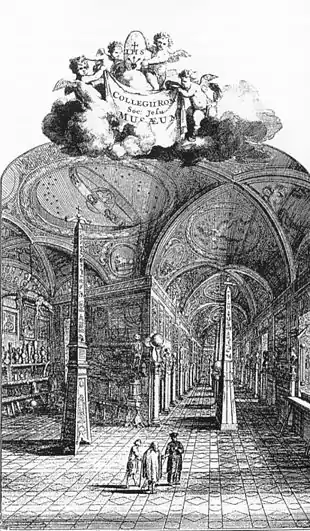Kircherian Museum
The Kircherian Museum was a public collection of antiquities and curiosities, a Wunderkammer, founded in 1651 by the Jesuit father Athanasius Kircher in the Roman College.

Considered the first museum in the world, its collections were gradually dispersed over the centuries.
History
In 1651 Alfonso Donnini, an Italian aristocrat and antiquarian, donated his "cabinet of curiosities" to the members of the Roman College. The collection contained "various curious and precious things so that they can take care of it and their studies may benefit from it". Father Athanasius Kircher (1602-1680), professor of mathematics, physics, and oriental languages, took care of the collection with great care and soon transformed it into a museum of antiquity, technology, art, science, and archeology.
Already famous and admired by the most enlightened minds of his time and by his students at the Roman College for his vast scientific knowledge and philosophical eclecticism, Kircher added natural history objects collected during his expeditions to Sicily (1630) and Malta (1636), musical instruments and even machines of his own invention. He used his contacts, particularly Jesuits abroad, to augment ethnographic collections with exotic objects from overseas missions.
The museum quickly became popular and hosted many visitors. A first catalog was published in 1678 by Giorgio de Sepibus and included some illustrated tables, today the only evidence of the layout. After Kircher's death in 1680 the museum went through a period of neglect. It took on new life and vigor thanks to the activity of the new curator Filippo Bonanni who published a second catalog in 1709. By comparing the two catalogs, it can be seen that many objects had already disappeared from the collection. Over time the museum regained its former glory and thanks to the aid received and the many donations, it became the seat of many important collections that touched all fields of knowledge, from experimental philosophy to esotericism to technology. The archeology collection was expanded by the Jesuit Contuccio Contucci, director of the museum between 1735 and 1765.[1]
The dispersement
The last Jesuit director of the Museum was the scholar Antonio Maria Ambrogi (1713 - 1788). In 1773, following the Suppression of the Jesuits by Clement XIV, the Roman College was entrusted to the clergy of Rome and the collections began to undergo the first drastic alterations: many finds ended up in the Pio-Clementino Museum in the Vatican Museums. In 1814, the Society of Jesus was reconstituted by Pius VII and in 1824 Leo XII returned the college and museum to the Jesuits. From 1839 onwards the museum was directed by Giuseppe Marchi for almost twenty years, which attempted a reorganization and produced a monograph on the ancient coins preserved there, the Aes grave of the Kircherian Museum.
When Rome was conquered in 1870 and became the capital of the Kingdom of Italy, most of the ecclesiastical properties were expropriated by the new unitary state: the Liceo ginnasio Visconti and the National Central Library were placed in the Roman College. The Kircherian Museum also became a state museum and between 1881 and 1913 was directed by Luigi Pigorini, who increased it by adding the National Ethnographic Prehistoric Museum to it.[2]
Only in 1913 a decree of the Ministry of Education authorized the definitive dispersion of the collections,[3] which were distributed in the new state museums of the capital: the Etruscan and Italic antiquities went to the National Etruscan Museum, the Roman ones to the National Roman Museum, the and Renaissance buildings in Castel Sant'Angelo and, since 1916, in the new Museo nazionale del Palazzo di Venezia. Some curiosities, such as the wooden models of the Roman obelisks, remained at the college; the Pigorini National Museum of Prehistory and Ethnography was finally transferred to EUR in the 1960s.
In recent years, the teachers and pupils of the Liceo Visconti have prepared a museum layout that recalls the historic Kircherian museum.[4]
Exhibition
An exhibition dedicated to the ancient Kircher Museum was held in Rome at Palazzo Venezia between 28 February and 22 April 2001. On that occasion, the Ministry for Cultural Heritage and Activities published a catalog containing many photos of objects that belonged to the Kircher Museum and are now distributed in various institutions. The chapters show the great variety of the museum sections: from oriental exoticism to the ethnological discoveries of the missionaries, from astronomy to earth sciences ( volcanology, zoology, etc.), from Egyptology ( hieroglyphs ) to hermeticism, from science to technology (shorthand, polygraphy, diving bell, etc.), from the picture gallery of the Roman College to Greek and Roman archeology.
References
- "La raccolta del Museo Kircheriano". Archived from the original on 30 July 2018.
- Cfr. "Il Museo Nazionale Preistorico Etnografico di Luigi Pigorini" (PDF). iipp.it. Retrieved 20 October 2020.
- Ottavio Cicchinelli (30 January 2017). "Athanasio Kircher in Italia" (in Italian). Retrieved 20 October 2020.
- Cfr. "Wunder Musaeum". wundermusaeum.com. Retrieved 8 September 2020.
Bibliography

- Encyclopedism in Baroque Rome: Athanasius Kircher and the Museo del Collegio Romano between Wunderkammer and the scientific museum, curated by Maristella Casciato. Venice, Marsilio 1986. ISBN 88-317-4846-7
- Athanasius Kircher - the museum of the world [Rome, Palazzo di Venezia, February 28 - April 22, 2001], Ministry for Cultural Heritage and Activities, Central Office for Archival Heritage. Curated by Eugenio Lo Sardo. Rome, De Luca 2001. ISBN 88-8016-421-X, ISBN 88-8016-409-0
- Claudia Cerchiai (edited by), The Roman College from its origins to the Ministry for Cultural Heritage and Activities, Rome, 2003.
- Alberto Bartòla, «At the origins of the Roman College museum. Documents and testimonies ", in Nuncius, 1, 2004, pp. 297–356.
- Angela Mayer-Deutsch, Das Museum Kircherianum. Kontemplative Momente, historische Rekonstruktion, Bildrhetorik, Zürich, 2010.
- Nathalie Lallemand-Buyssens, «The acquisitions of Athanasius Kircher in the museum of the Romain Collège à la lumière de documents inédits», in History of Art, n. 133, Oct-Dec 2012, pp. 107–129.